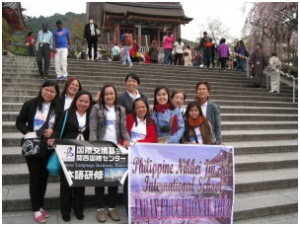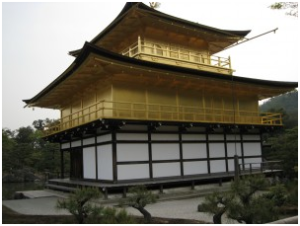April 14, 2014, in the evening, PNJK-IS team arrived at Kansai Airport, Osaka, Japan. In a few minutes, the bus owned by the Japan Foundation Japanese Language Institute, Kansai, came on schedule.
Upon reaching the Institute, each was handed an envelope containing instructions as regards the schedule of classes, trip to Kyoto, the use of our IDs and meal time.
The following day, we underwent orientation and self-introduction ceremony. Hee-jeong Shin san was our emcee and took the liberty of introducing to us the composition of the staff in the Learning Section. Her English is flawless but of course Nihongo was used most of the time.
The Vice-Director of Japan Foundation Akihiko Murata San gave his welcome address. The word “lucky” was given emphasis in his message. Truly, we were lucky because not only was the weather very cooperative but the sakura flowers were still in full bloom. You see along the avenue trees bearing sakura flowers of various colors.
The next was the tour of the center. We were ushered to two storey buildings where classes are held. You see students from other countries in the classroom and even in corridors during their free time. We then proceeded to the canteen and how to order food during meal period. The security area was part of the tour as well as the exterior part of the edifice. The facilities are so impressive that all basic needs are within your reach.
In the afternoon classes intended for our group commenced. What is admirable is that all of the staff and teachers can speak English. You will be amazed how good they are and so courteous, kind and accommodating. Evening of the second day the group went out of the Center. A bus is there for the use of the occupants of the center. There is a schedule when the bus leaves the Center and the time it goes back. The ride was free provided the destination is the Namba area. It was fun to explore in unfamiliar area and how to put into use the little knowledge that you have in Nihongo.
April 16, 2014 was the trip to Kyoto. Shin san was with us, so gorgeous that you feel baffled why a native of Korea is in Japan working just like any ordinary Japanese without any qualms. We had a tour guide. A good one and can crack joke without changing facial expression. At times you find yourself believing in what he just said.
My task is the visit to Golden Pavilion in Kyoto. The other name of the Golden Pavilion is Kinkaku. The visit took place on April 16, 2014. It was an exciting and enjoyable trip with a lot of souvenir shops lined up along the pathway going to the site. We were forewarned by the tour guide before proceeding to the temple that we should be alert at all times lest one or more will be lost due to the presence of hundreds of tourists composed of students who were on field trip, group of Japanese adults and foreigners like us.
Kinkaku (The Golden Pavilion) originally was known as Rokuon-ju Temple. It is a zen Buddist temple. Because of its fame the former US President George Bush visited the site and took photos of a very unique heritage of Japan.
The Golden Pavilion is surrounded by a man-made lake and can be seen at a distance. The temple is a three-storey edifice and each floor has different designs. Koto Nobu residence style can be found at the
first floor while the second floor is samurai style and the third is zen style. The ceiling is covered with gold. About 20 kilos were used. Installed on the floor is black lacquer and because of its reflection goldis very prominent. On the side of the floor ashes are kept. Buddhist ashes and bone are stored on that side. Looking closely at the Golden Pavilion square miniature carved on the wall is noticeable. Those represent about 200 thousand set of real gold leaf weighing 20 kilos assessed at more than 700 million yen.
The Golden Pavilion is accessible only to the King and the Prince. No other person is allowed to enter the said temple. On top of the temple is an oriental phoenix, a symbol of happiness. According to some, Phoenix represents shogun that looks after Japan.
After the temple we were ushered to a bonsai tree which is 600 years old. In the beginning it was so small but shogun loved it so much that he planted it on the spot as photographed and has grown that big yet still considered as bonsai.
There is a tea house right within the area where the Golden Pavilion is located. The kinkaku is especially beautiful when seen from the tea house late in the afternoon sun. This view is reflected in the tea house named Sekkatei (Place of Evening Beauty).
At the temple is a statute of the Buddhist Deity Fudo-Ryo-o. It is believed that the statute was made in the 9th century. Though hidden from the public view, the image has long been revered for its miraculous powers. Open door rituals are held on Setsubun early February and on August 16.
April 17, 2014 was the day of proving to all of the success of the learning session. All participants were asked to state in the Japanese language the experience encountered in Kyoto. Though not perfectly delivered, there was, to my assessment, 80% satisfaction of the performance of everyone. Our graduation came to an end with memories that will forever be cherished by each. The generosity of Japan Foundation Japanese Language Institute in allowing the group to stay is highly appreciated. We have witnessed the patience and understanding demonstrated by the teachers and staff to all who are still struggling in learning the language as well as embracing the culture that we aim to inculcate to our students and even to our members of the family. Preserving the heritage is one and what is most important is time consciousness. To me time is gold. We can more if time management is well observed.
Let me thank the management of Japan Foundation Japanese Language Institute for this rare opportunity allowing us the use of the center and study the language even for such a short stint and the chance to see Osaka, Japan more so the preserved heritage in Kyoto. Thank you so much – from the PNJK International School Group and we hope to see you all in one of your visits in our place.




